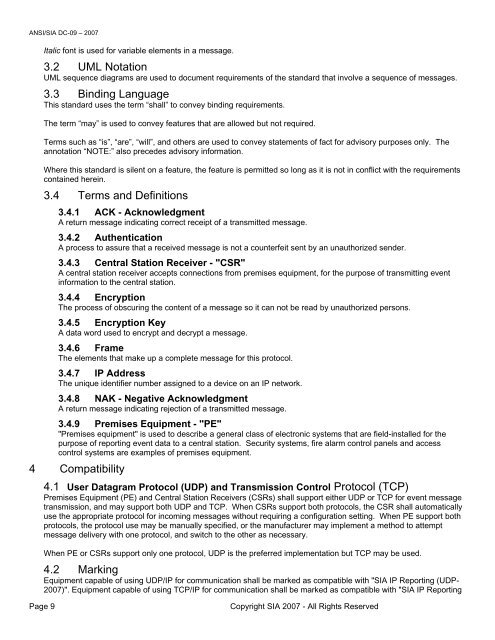SIA Digital Communication Standard – Internet Protocol Event ...
SIA Digital Communication Standard – Internet Protocol Event ...
SIA Digital Communication Standard – Internet Protocol Event ...
You also want an ePaper? Increase the reach of your titles
YUMPU automatically turns print PDFs into web optimized ePapers that Google loves.
ANSI/<strong>SIA</strong> DC-09 <strong>–</strong> 2007<br />
Italic font is used for variable elements in a message.<br />
3.2 UML Notation<br />
UML sequence diagrams are used to document requirements of the standard that involve a sequence of messages.<br />
3.3 Binding Language<br />
This standard uses the term “shall” to convey binding requirements.<br />
The term “may” is used to convey features that are allowed but not required.<br />
Terms such as “is”, “are”, “will”, and others are used to convey statements of fact for advisory purposes only. The<br />
annotation “NOTE:” also precedes advisory information.<br />
Where this standard is silent on a feature, the feature is permitted so long as it is not in conflict with the requirements<br />
contained herein.<br />
3.4 Terms and Definitions<br />
3.4.1 ACK - Acknowledgment<br />
A return message indicating correct receipt of a transmitted message.<br />
3.4.2 Authentication<br />
A process to assure that a received message is not a counterfeit sent by an unauthorized sender.<br />
3.4.3 Central Station Receiver - "CSR"<br />
A central station receiver accepts connections from premises equipment, for the purpose of transmitting event<br />
information to the central station.<br />
3.4.4 Encryption<br />
The process of obscuring the content of a message so it can not be read by unauthorized persons.<br />
3.4.5 Encryption Key<br />
A data word used to encrypt and decrypt a message.<br />
3.4.6 Frame<br />
The elements that make up a complete message for this protocol.<br />
3.4.7 IP Address<br />
The unique identifier number assigned to a device on an IP network.<br />
3.4.8 NAK - Negative Acknowledgment<br />
A return message indicating rejection of a transmitted message.<br />
3.4.9 Premises Equipment - "PE"<br />
"Premises equipment" is used to describe a general class of electronic systems that are field-installed for the<br />
purpose of reporting event data to a central station. Security systems, fire alarm control panels and access<br />
control systems are examples of premises equipment.<br />
4 Compatibility<br />
4.1 User Datagram <strong>Protocol</strong> (UDP) and Transmission Control <strong>Protocol</strong> (TCP)<br />
Premises Equipment (PE) and Central Station Receivers (CSRs) shall support either UDP or TCP for event message<br />
transmission, and may support both UDP and TCP. When CSRs support both protocols, the CSR shall automatically<br />
use the appropriate protocol for incoming messages without requiring a configuration setting. When PE support both<br />
protocols, the protocol use may be manually specified, or the manufacturer may implement a method to attempt<br />
message delivery with one protocol, and switch to the other as necessary.<br />
When PE or CSRs support only one protocol, UDP is the preferred implementation but TCP may be used.<br />
4.2 Marking<br />
Equipment capable of using UDP/IP for communication shall be marked as compatible with "<strong>SIA</strong> IP Reporting (UDP-<br />
2007)". Equipment capable of using TCP/IP for communication shall be marked as compatible with "<strong>SIA</strong> IP Reporting<br />
Page 9 Copyright <strong>SIA</strong> 2007 - All Rights Reserved

















